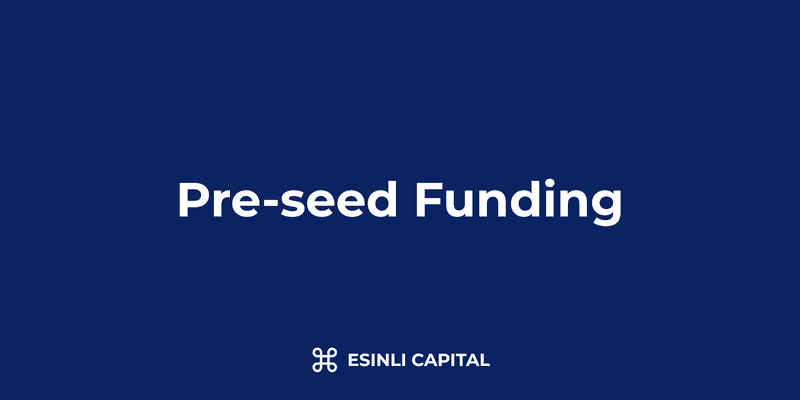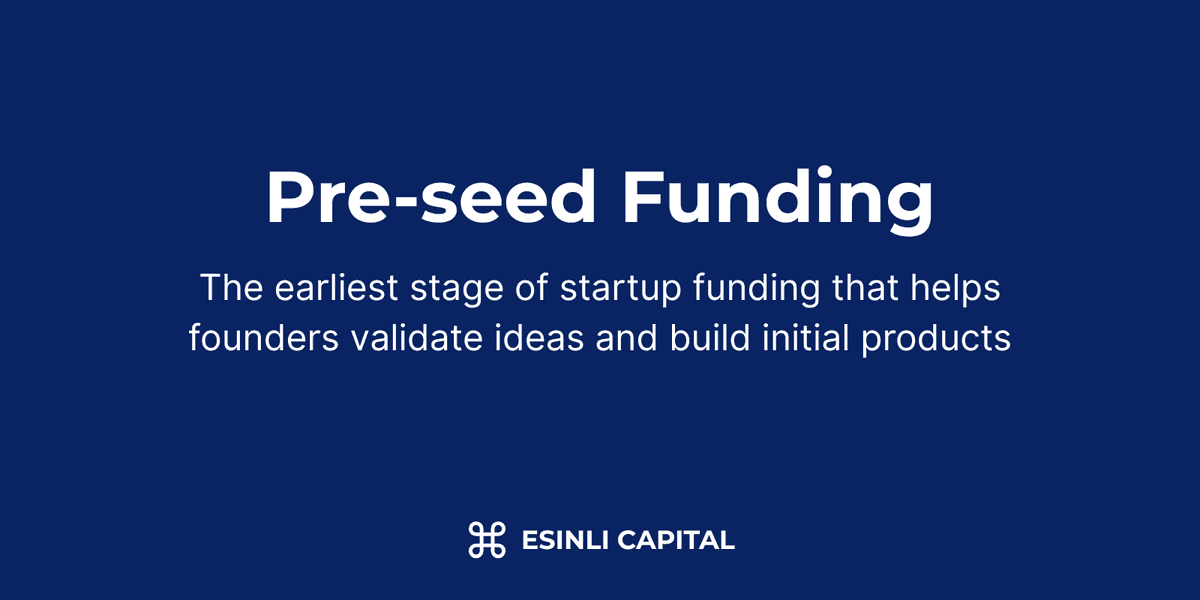In This Article
- What Is Pre-seed Funding?
- Understanding the Pre-seed Funding Stage
- Sources of Pre-seed Funding
- Typical Pre-seed Funding Amounts
- What Pre-seed Investors Look For
- Preparing for Pre-seed Fundraising
- Valuation Methods for Pre-seed Startups
- Common Pre-seed Funding Challenges
- After Securing Pre-seed Funding
- Pre-seed Funding: Future Trends and Outlook
- The Bottom Line
- What Is Pre-seed Funding?
- Understanding the Pre-seed Funding Stage
- Sources of Pre-seed Funding
- Typical Pre-seed Funding Amounts
- What Pre-seed Investors Look For
- Preparing for Pre-seed Fundraising
- Valuation Methods for Pre-seed Startups
- Common Pre-seed Funding Challenges
- After Securing Pre-seed Funding
- Pre-seed Funding: Future Trends and Outlook
- The Bottom Line

Pre-seed Funding: Sources, Amounts & Investor Expectations
KEY TAKEAWAYS
- Pre-seed funding typically ranges from $50,000 to $500,000 and focuses on idea validation and initial product development
- Common sources include founder savings, friends and family, angel investors, accelerators, and specialized pre-seed funds
- Investors at this stage primarily evaluate the founding team, problem-solution fit, and market potential rather than financial metrics
- Most startups need to demonstrate some validation through customer discovery, a prototype, or clear expertise in their industry
- Pre-seed rounds usually exchange 5-15% equity, often through convertible notes or SAFEs rather than priced rounds
What Is Pre-seed Funding?
Pre-seed funding is the earliest stage of startup financing that occurs when a company is still in the conceptual or early development phase. This funding round helps founders move from an initial idea to a minimum viable product (MVP), conduct market research, and validate core assumptions before seeking larger investments. Pre-seed funding bridges the gap between personal funding and more formalized seed rounds, allowing founders to build enough traction to attract later investors.
Pre-seed capital is typically raised before a company has significant revenue, a complete product, or a fully established customer base. The funding is often used to support founding team salaries, product development costs, initial marketing efforts, and other expenses required to transform an idea into a tangible business with early validation.
Understanding the Pre-seed Funding Stage
Pre-seed funding emerged as a distinct investment category around 2015 as the gap between bootstrapping and traditional seed rounds widened. As seed rounds grew larger (often $1-3 million), an earlier funding stage became necessary for companies not yet ready for such significant investments.
When Is Pre-seed Funding Appropriate?
A startup is typically ready for pre-seed funding when:
- The founders have developed a clear business concept but need capital to build an MVP
- There's preliminary evidence of market demand through customer interviews or problem validation
- The team has relevant expertise but requires financial resources to work full-time on the venture
- The company has exhausted personal resources but isn't yet ready for a formal seed round
This funding stage usually occurs within the first 6-12 months of a startup's existence, though the timeline can vary depending on the industry, technology complexity, and founder experience.
Pre-seed vs. Seed Funding: Key Differences
| Aspect | Pre-seed Funding | Seed Funding |
|---|---|---|
| Typical Amount | $50,000-$500,000 | $1-3 million |
| Company Stage | Conceptual/early prototype | Working MVP with early traction |
| Primary Purpose | Idea validation and MVP development | Product-market fit and growth |
| Key Metrics | Team quality and problem validation | Initial user metrics and growth potential |
| Investor Types | Angels, friends/family, accelerators | Seed VCs, angel syndicates, larger seed funds |
| Typical Valuation | $1-3 million | $5-10 million |
| Funding Instrument | SAFE or convertible note | Convertible notes or priced equity |
Sources of Pre-seed Funding
Securing pre-seed capital requires looking beyond traditional venture capital firms. Here are the primary sources available to founders:
1. Founder Self-funding (Bootstrapping)
Many founders initially invest their own savings to get their startups off the ground. This approach, known as bootstrapping, demonstrates personal commitment and can be attractive to future investors. Consider:
- Setting aside 6-12 months of personal runway
- Being strategic with expenses by focusing on essential development needs
- Maintaining a part-time job or consulting work to extend your financial runway
2. Friends and Family
Investment from personal connections (friends and family rounds) often represents the first external capital many startups receive. This funding source offers several advantages:
- Typically involves simpler terms than professional investors
- Based on personal relationships and belief in the founder
- Usually faster to secure than institutional funding
When raising from friends and family, maintain professionalism by:
- Creating proper legal documentation
- Setting clear expectations about risks
- Establishing formal terms rather than handshake agreements
- Being transparent about how the money will be used
3. Angel Investors
Angel investors are high-net-worth individuals who invest their personal capital in early-stage startups. They typically:
- Invest between $25,000 and $100,000 in pre-seed rounds
- Provide not just capital but also mentorship and connections
- Often have entrepreneurial experience themselves
- May specialize in specific industries or technologies
Finding angel investors requires networking through:
- Local startup events and founder communities
- Angel investor networks and online platforms like AngelList
- Industry-specific conferences and meetups
- Introductions from other founders or advisors
4. Pre-seed Funds
Specialized pre-seed venture funds have emerged to fill the gap between angel investments and traditional seed funds. These funds:
- Focus exclusively on very early-stage companies
- Typically invest $100,000-$500,000
- Often have streamlined due diligence processes
- May participate in syndicates with angel investors
- Usually offer value beyond capital through their networks and expertise
Examples of notable pre-seed funds include Hustle Fund, Precursor Ventures, and Afore Capital.
5. Accelerators and Incubators
Startup accelerators and incubators provide structured programs that include funding, mentorship, and education. Top programs:
- Offer funding ranging from $20,000 to $150,000 in exchange for equity (typically 5-10%)
- Provide structured programming over 3-6 months
- Connect founders with mentors and potential investors
- Culminate in a "demo day" where startups pitch to investors
Well-known accelerators with pre-seed investment components include Y Combinator, Techstars, and 500 Startups.
6. Crowdfunding
Equity crowdfunding platforms allow startups to raise capital from numerous small investors:
- Platforms include Republic, SeedInvest, and WeFunder
- Typically requires having an engaged network or community
- Can double as market validation and customer acquisition
- May involve regulatory complexities depending on the platform and fundraising amount
7. Government Grants and Programs
Many governments offer grants, tax incentives, or specialized programs for early-stage startups:
- Often non-dilutive (no equity exchanged)
- May focus on specific industries or technologies
- Application processes can be lengthy but worthwhile
- Examples include SBIR/STTR grants in the US and various regional innovation funds
Typical Pre-seed Funding Amounts
Pre-seed funding amounts vary widely depending on factors such as industry, geography, and founder experience. However, some general patterns emerge:
By Industry
| Industry | Typical Pre-seed Range | Notes |
|---|---|---|
| Software/SaaS | $200,000-$500,000 | Lower capital requirements for initial development |
| Consumer Apps | $150,000-$400,000 | Focus on user acquisition and engagement testing |
| Deep Tech/Hardware | $300,000-$800,000 | Higher costs for prototyping and technical validation |
| Fintech | $250,000-$600,000 | Regulatory considerations and compliance needs |
| Biotech/Medtech | $500,000-$1M+ | Higher barriers to entry and longer timelines |
By Geography
Pre-seed funding amounts show significant regional variation:
- Silicon Valley/NYC: $300,000-$750,000 (higher costs but also larger available funding pools)
- Other Major US Tech Hubs: $200,000-$500,000 (Boston, Los Angeles, Austin, etc.)
- Europe: €150,000-€400,000 (varies significantly by country)
- Southeast Asia: $100,000-$300,000 (emerging ecosystem with growing investor interest)
- Latin America: $75,000-$250,000 (rapidly evolving funding environment)
How Much to Raise
When determining your pre-seed funding target, consider:
- Runway calculation: Typically 12-18 months of operating expenses
- Key milestones: Identify what specific achievements will enable a seed round
- Burn rate: Monthly expenses including salaries, development costs, and operating expenses
- Buffer: Add 20-30% for unexpected costs or delays
Most successful founders recommend raising enough to achieve meaningful milestones plus a 3-6 month buffer for fundraising the next round.
What Pre-seed Investors Look For
At the pre-seed stage, investors evaluate different criteria than at later stages, focusing more on potential than proven metrics:
1. Founding Team
The team is often the most critical factor in pre-seed investment decisions:
- Relevant experience: Domain expertise or specific technical skills
- Founder-market fit: Why these specific founders are uniquely positioned to solve this problem
- Complementary skills: Balance of technical, business, and industry expertise
- Coachability: Willingness to adapt based on feedback and market signals
- Commitment: Full-time dedication and significant personal investment (time or money)
2. Problem-Solution Fit
Investors want to see evidence that:
- The problem is significant, specific, and clearly articulated
- The target customers acknowledge this problem as important
- The proposed solution addresses the problem in a meaningfully better way than alternatives
- Founders have conducted thorough customer discovery to validate their assumptions
3. Market Opportunity
Even at the earliest stage, investors consider market dynamics:
- Market size: Total addressable market large enough to support venture-scale returns
- Growth trajectory: Evidence the market is expanding or evolving favorably
- Competitive landscape: Understanding of existing solutions and competitive advantages
- Go-to-market strategy: Initial approach to reaching early customers
4. Early Validation
Some form of validation strengthens pre-seed fundraising efforts:
- Customer interviews: Documented conversations showing problem validation
- LOIs (Letters of Intent): Non-binding commitments from potential customers
- Waitlist or pre-orders: Demonstrated interest from potential users
- Early prototype or MVP: Working demonstration of core functionality
- Previous success: Track record of achievements in related ventures
5. Capital Efficiency
Investors want to see thoughtful planning for how funds will be used:
- Clear milestones tied to specific funding amounts
- Realistic understanding of costs and timelines
- Focus on validating key assumptions before scaling
- Strategic prioritization of critical versus nice-to-have features
Preparing for Pre-seed Fundraising
A successful pre-seed raise requires thorough preparation:
Essential Documents
Prepare these key materials:
- Pitch deck: 10-15 slides covering the problem, solution, market, team, traction, and funding needs
- Financial model: Basic projections showing how funds will be used
- Demo or prototype: Even rudimentary prototypes significantly strengthen your case
- Technical documentation: Especially important for deep tech or complex products
- Customer discovery findings: Summarized insights from user research
Building Your Network
Begin cultivating investor relationships well before actively fundraising:
- Attend industry events and startup meetups
- Join founder communities and accelerator networks
- Leverage LinkedIn to connect with relevant investors
- Ask for warm introductions from other founders
- Contribute to online communities where investors participate
Creating FOMO (Fear of Missing Out)
Strategic approaches to generate investor interest:
- Build momentum by securing a lead investor first
- Create a clear timeline for closing the round
- Demonstrate progress during the fundraising process
- Leverage small wins and milestones to create urgency
- Consider running a coordinated process rather than sequential meetings
Valuation Methods for Pre-seed Startups
Determining valuation at the pre-seed stage is more art than science:
Common Approaches
- Comparable analysis: Examining valuations of similar startups at the same stage
- Investor ownership target: Backing into a valuation based on desired equity stake (typically 15-25% for the entire pre-seed round)
- Milestone-based valuation: Setting value based on achievements and future milestones
- Replacement cost: Estimating what it would cost to recreate the current state of the business
- Rule of thumb: In many markets, typical pre-seed valuations range from $1-3 million pre-money
Funding Instruments
At the pre-seed stage, these funding vehicles are most common:
Convertible Notes
Debt instruments that convert to equity at a later priced round, with key terms including:
- Discount rate: Typically 15-25%, providing early investors a better price when converting
- Valuation cap: Maximum valuation at which the note converts, usually $3-7 million
- Interest rate: Usually 2-8% annually, accruing until conversion
- Maturity date: When the note must be repaid or converted (typically 18-24 months)
SAFE Agreements (Simple Agreement for Future Equity)
Created by Y Combinator, SAFEs have become increasingly popular for pre-seed rounds:
- No interest rate or maturity date
- Simpler and more founder-friendly than convertible notes
- Main terms include discount rate and valuation cap
- Various versions exist, including post-money SAFEs that provide clearer ownership percentages
Direct Equity
Less common at pre-seed but sometimes used:
- Requires setting a specific valuation early on
- More complex and expensive legal process
- Provides clarity on ownership percentages
- Often uses preferred stock with liquidation preferences
Common Pre-seed Funding Challenges
Founders face several obstacles during pre-seed fundraising:
1. The "Too Early" Objection
Many investors claim interest but say you're "too early." Strategies to overcome this:
- Focus on investors who specifically target pre-seed deals
- Emphasize the team's unique qualifications and insights
- Provide concrete evidence of problem validation
- Create FOMO by securing commitment from respected angels
2. Long Fundraising Timelines
Pre-seed rounds often take 3-6 months to complete. To manage this:
- Build a 6+ month runway before beginning fundraising
- Run a parallel process with multiple investor conversations
- Continue building and showing progress during fundraising
- Consider raising from fewer sources to simplify the process
3. Balancing Building and Fundraising
Fundraising demands significant time while product development continues:
- Dedicate specific time blocks for investor meetings and follow-ups
- Consider having one founder focus on fundraising while others maintain momentum on product
- Set clear internal milestones to achieve during the fundraising process
- Use fundraising conversations as market research to improve your offering
4. Navigating Due Diligence
Even at the pre-seed stage, investors will conduct some level of due diligence:
- Organize your corporate, financial, and technical documentation in advance
- Prepare references from advisors, customers, or former colleagues
- Be transparent about challenges and risks
- Have clear answers about intellectual property ownership
After Securing Pre-seed Funding
Once you've closed your pre-seed round, focus on maximizing the impact of this capital:
Setting Milestones
Establish clear objectives that will position you for a seed round:
- Product milestones: Specific features or technical achievements
- Customer milestones: User acquisition targets or engagement metrics
- Revenue milestones: Initial monetization or commercial agreements
- Team milestones: Key hires to fill crucial skill gaps
Managing Investor Relationships
Maintain strong communication with your investors:
- Send regular updates (monthly or quarterly)
- Be transparent about challenges as well as successes
- Leverage their networks and expertise beyond just capital
- Set clear expectations about timeline to next fundraising
Planning for the Seed Round
Begin positioning for your next fundraise:
- Identify metrics that seed investors in your space typically expect
- Research potential seed funds 3-6 months before needing to raise
- Build relationships with seed investors before actively fundraising
- Collect and document customer testimonials and case studies
Pre-seed Funding: Future Trends and Outlook
The pre-seed funding landscape continues to evolve:
Emerging Trends
- Specialized micro-funds: Increasingly focused funds targeting specific industries or founder demographics
- Operator-angels: Growing prominence of successful founders and executives investing at pre-seed
- Alternative financing: Revenue-based financing and other non-dilutive options complementing equity
- Remote fundraising: Permanently expanded geographic access to investors beyond local networks
- Community-based fundraising: Platforms enabling founders to raise from their users and supporters
Regional Developments
Pre-seed ecosystems are developing globally:
- Emerging markets: Significant growth in Southeast Asia, Latin America, and Africa
- Government initiatives: Increasing public sector support through matching funds and tax incentives
- University ecosystems: Academic institutions creating more robust funding and support programs
The Bottom Line
Pre-seed funding represents a critical bridge between a startup idea and a venture-ready business with demonstrable potential. By understanding investor expectations, preparing thoroughly, and strategically approaching the right funding sources, founders can secure the capital needed to validate their core hypotheses and build the foundation for a successful company.
The most successful pre-seed fundraisers combine compelling vision with concrete evidence of progress, even at this earliest stage. They focus on building relationships with the right investors, creating clear milestones tied to funding amounts, and maintaining momentum throughout the fundraising process.
While raising pre-seed capital presents unique challenges, it also offers founders their first opportunity to externally validate their business concept and begin building the investor relationships that can support their company through future growth stages.
The comments, opinions, and analyses expressed on Investopedia are for informational purposes only. Read our warranty and liability disclaimer for more info.



